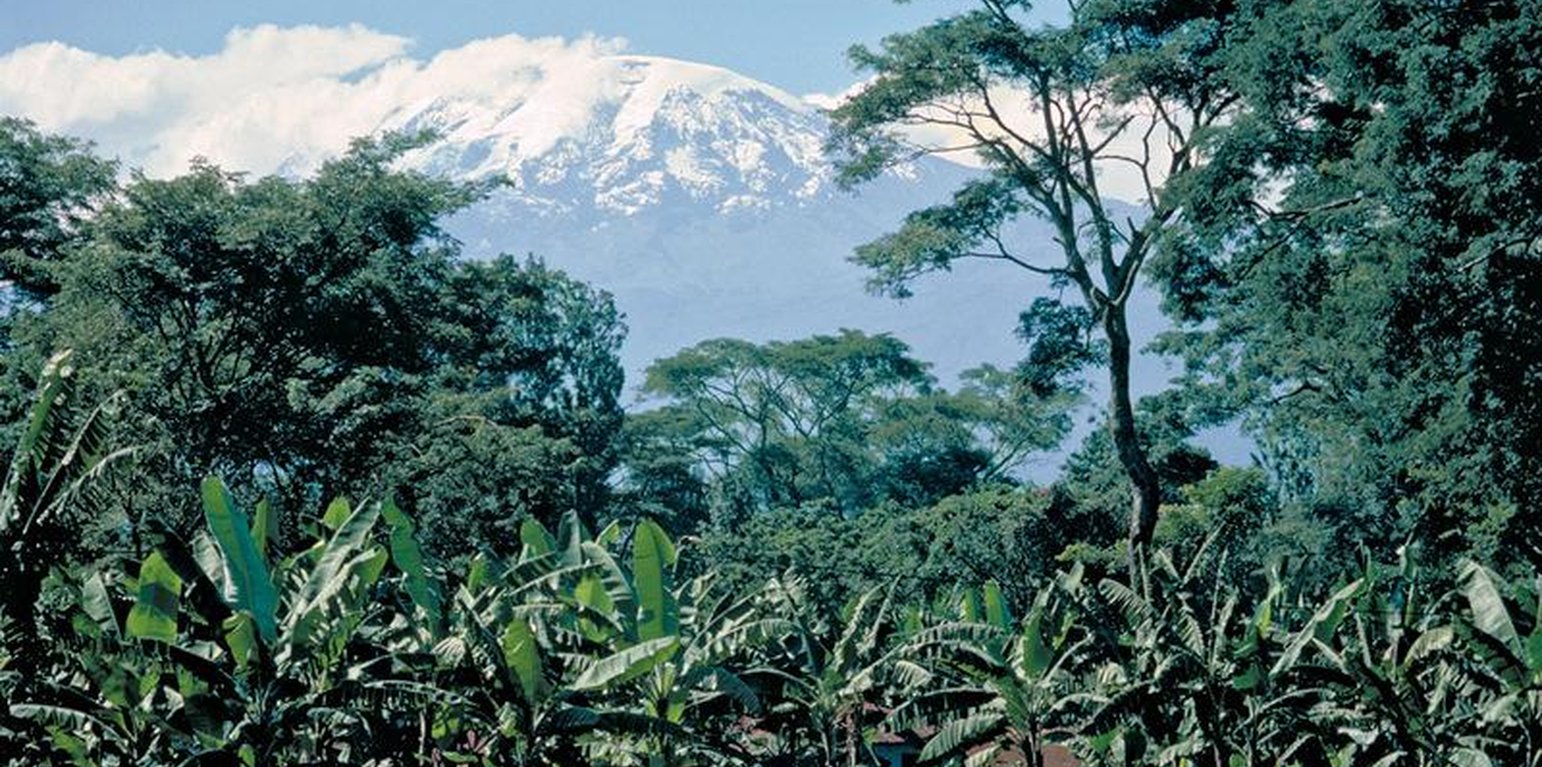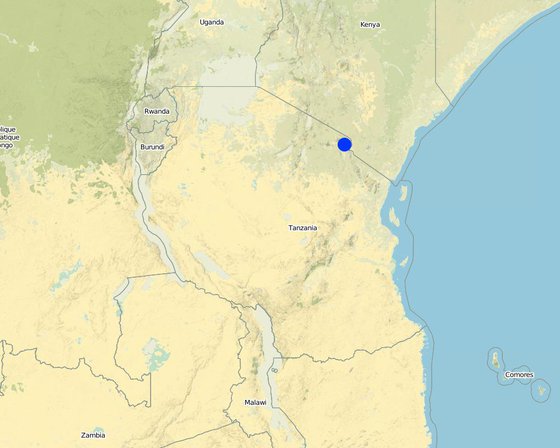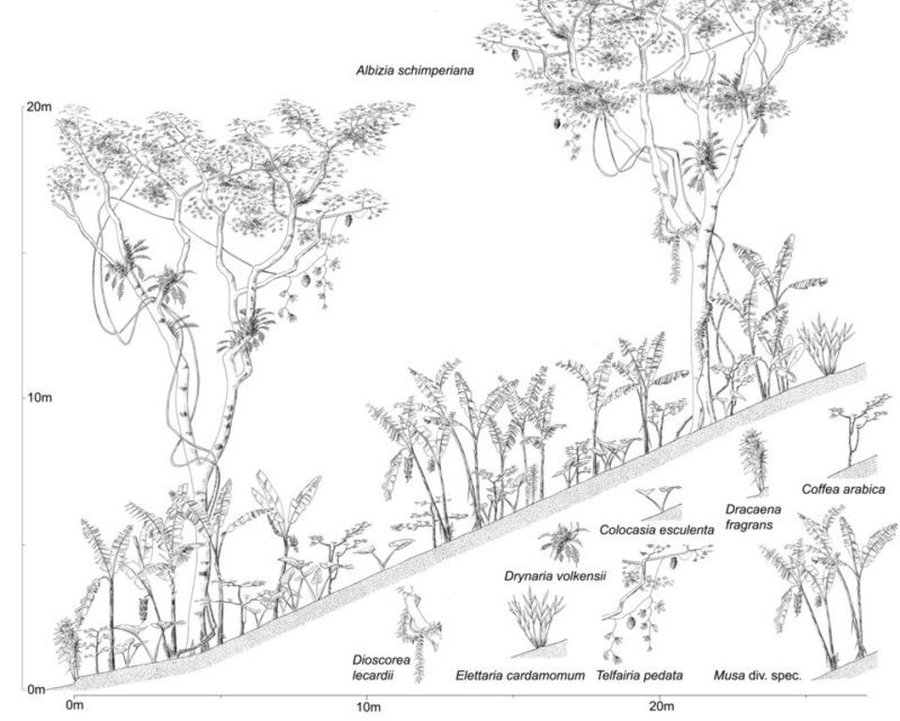



The complex multicropping system evolved over several centuries through a gradual transformation of the natural forest on the footslopes of Kilimanjaro. A Chagga homegarden has an average size of 0.68 ha and integrates numerous multipurpose trees and shrubs with food crops, and stall-fed animals, without a specific spatial arrangement. However, vertically, the following 4 stories/canopies can be distinguished: (1) food crops: taro, beans, vegetables and fodder herbs / grasses; (2) coffee: 500-1,400 plants/ha; (3) banana: primary crop; 50% cover; 330-1,200 clumps/ha; and (4) Trees, such as Cordia abyssinica, Albizia schimperiana and Grevillea robusta. The trees provide shade for coffee, act as live fences, provide medicines, firewood, fodder, mulching material, bee forage; and some have pesticidal properties (e.g. Rauwolfia caffra). This multilayer system maximizes the use of limited land in a highly populated area, making sustained production possible with a minimum of external inputs, minimizes risk (less production failure, increased resistance against droughts and pests) and ensures at the same time environmental protection. The large species diversity provides both subsistence and cash crops. Parts of the homegarden area are irrigated and drained by a network of over 1000 canals and furrows tapping runoff from the montane forest. However, many systems are now in disrepair.
Natural / human environment: Starting in the 1930s when coffee took more space from the food production, it became necessary to expand food production to the lowlands. Today, the Chagga highland homegarden works only in combination with a lowland field where maize, millet, beans, sunflower and groundnuts are grown to ensure food security.

ទីតាំង: Mt. Kilimanjaro Region, ប្រទេសតង់សានី
ចំនួនទីកន្លែងបច្ចេកទេស ដែលវិភាគ:
ការសាយភាយនៃបច្ចេកទេស:
តើស្ថិតក្នុងតំបន់ការពារអចិន្ត្រៃយ៍?:
កាលបរិច្ឆេទនៃការអនុវត្ត: ច្រើនជាង 50 ឆ្នាំមុន (ប្រពៃណី)
ប្រភេទនៃការណែនាំឱ្យអនុវត្តន៍៖







| បញ្ជាក់ពីធាតុចូល | ឯកតា | បរិមាណ | ថ្លៃដើមក្នុងមួយឯកតា (ដុល្លារ) | ថ្លៃធាតុចូលសរុប (ដុល្លារ) | % នៃថ្លៃដើមដែលចំណាយដោយអ្នកប្រើប្រាស់ដី |
| កម្លាំងពលកម្ម | |||||
| Planting, tending and harvesting | unit | 1,0 | 300,0 | 300,0 | 100,0 |
| សម្ភារៈ | |||||
| Tools | unit | 1,0 | 45,0 | 45,0 | 100,0 |
| ជី និងសារធាតុពុល | |||||
| Compost / manure | unit | 1,0 | 100,0 | 100,0 | 100,0 |
| ថ្លៃដើមសរុបសម្រាប់ការថែទាំដំណាំតាមបច្ចេកទេស | 445.0 | ||||
| ថ្លៃដើមសរុបសម្រាប់ការថែទាំដំណាំតាមបច្ចេកទេសគិតជាដុល្លារ | 445.0 | ||||
Fuelwood production 1.5-3 m3/ha/year
185 kg beans/ha; 410 kg coffee/ha; 400 bunches of banana /ha; ca. 30 kg honey/ha
increased labour efficiency
for breeding programmes to improve crop varieties for multistorey cropping systems
over 500 plant species including 400 non-cultivated plants
? land use change from natural forest to agroforest